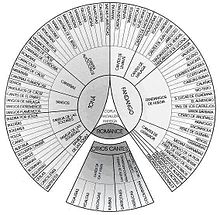
The Andalusian cadence (diatonic phrygian tetrachord) is a term adopted from flamenco music for a chord progression comprising four chords descending stepwise – a iv–III–II–I progression with respect to the Phrygian mode or i–VII–VI–V progression with respect to the Aeolian mode (minor).[1] It is otherwise known as the minor descending tetrachord. Traceable back to the Renaissance, its effective sonorities made it one of the most popular progressions in classical music.
The Andalusian cadence can be regarded as a modulation between the Phrygian mode of a Major parent scale and the Phrygian Dominant mode of a Harmonic Minor scale, e.g. E, F, G (phrygian) or G ♯ (phrygian dominant), A, B, C, D.
Despite the name it is not a true cadence (i.e., occurring only once, when ending a phrase, section, or piece of music[2]); it is most often used as an ostinato (repeating over and over again). It is heard in rock songs such as "Runaway" by Del Shannon.[3]
- ^ Mojácar Flamenco Archived May 28, 2005, at the Wayback Machine, a website about basics in Flamenco music
- ^ Buciu, Dan (1989). Tonal Harmony, "Ciprian Porumbescu" Conservatory Publishing House, Bucharest
- ^ Kelly, Casey and Hodge, David (2011). The Complete Idiot's Guide to the Art of Songwriting, [page needed]. ISBN 978-1-61564-103-1. "i–VII–VI–V".